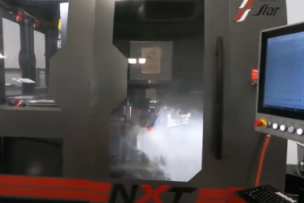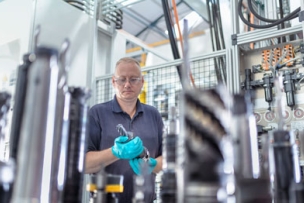Derek Nading, applications engineer for M.A. Ford Mfg. Co. Inc., agrees, noting that custom cutting tools are also quite common in the medical sector.
“We make a lot of special reamers and step drills for medical use, where a shop might want to complete two or more part features in one operation,” he says. “And barrel cutters, also known as circle segment tools, are becoming more popular as well, used primarily for accelerated finishing of hip replacements and other complex implants.”
Read more: 5 Ways Manufacturers Can Use Data Analytics to Improve Efficiency
KYOCERA SGS research and development engineer Jake Rutherford warns that cutting tool coatings might be forbidden in particular medical applications.
“That’s why we offer our tools coated or uncoated,” he says. “I've been to shops where it was difficult or even impossible to validate a process due to concerns there would be microscopic elements of the coating left behind on the component, which could, in turn, leach into the human body."
A Methodical Approach
Note that last term: process validation. Like those making critical aerospace components, medical shops must often submit their machining processes for customer approval, and once validated, are frozen in place. Any deviations from these processes after the fact require additional approvals, making continuous improvement cumbersome at best.
One moral to this story is that medical shops should bring in cutting tool experts early during the process development cycle. This helps ensure that they select the best tools, determine the most efficient toolpaths possible, and avoid going back to the customer for post-validation changes. In other cases, however, doing so is well worth the effort, especially on jobs that have been running for years, or where the shop is otherwise behind the times in terms of cutting tool technology.
One case in point comes from OSG USA Inc., where district manager Dustin Loschiavo works closely with a medical shop in Michigan.
“We and some of our engineers visited their facility last October after they agreed to partner with us,” Loschiavo says. “We evaluated their processes, looked at their machine tools and workholding, and delivered solutions that would save them more than $300,000 annually on just four components.”
OSG regional manager Chris Dravis isn’t surprised. “In this particular case, they were using 10-year-old cutting tool technology,” he says. “By moving them over to tools designed for modern toolpaths, they were able to greatly increase cutter engagement, significantly improving tool life and metal removal rates alike. Granted, there are internal costs associated with them going back to the customer and taking the time to re-validate the processes, but in this and many other instances, it’s well worth it.”
Read more: How to Ring-Test, Mount, Balance and Store Your Grinding Wheels
OSG district manager Aaron Kwapniewski agrees, noting that there are currently 6,500-plus domestic medical device manufacturers, and there continues to be a large demand on all of them to reduce lead times and trim prices. “If they’re not taking advantage of the latest and greatest tooling, they’re leaving money on the table and putting themselves at risk, perhaps, of losing business to other competitors,” he notes.
Dan Doiron of Emuge has had similar experiences. He says that strict protocols to ensure the consistency of implant manufacturing exist. Traceability is critical, requiring that businesses document what batch of material, which machine tool and even the type of cutting fluid they use for a specific part. “Changing to a different brand of cutting tool is generally not allowed without a review as to why that change is necessary,” he says. “Despite this, it’s often a necessary pain if shops are to stay competitive.”
Many of these parts are small, easily falling into micromachining territory. KYOCERA SGS applications engineer Jacob Rak listed off a handful of smaller medical components, from stents and bone screws to parts for heart pumps and respiration monitoring sensors. Swiss-style CNC lathes have long been used to machine many of these, with 5-axis machining centers more common for implant manufacturing.
“Medical parts often have unique geometries and are made from difficult materials, so it’s demanding work,” he says. “Regardless of what you’re making, you need the best equipment you can afford if you’re to be competitive.”
Raise the Toolholding Bar
Whatever the machine tool, whatever the part, tight tolerances and extremely fine surface finishes mean that manufacturers must also raise the bar on their toolholding. The need for minimal runout and maximum rigidity demands shrink-fit or hydraulic chuck use wherever possible. Tiny cutters might require investment in speeder heads to achieve the correct operating speed, and filtered, high-pressure coolant is a must. And always follow the cutting tool manufacturer’s recommendations—most agree that machinists are often afraid to push the tools as hard as they should, which usually leads to premature tool wear.
Some are also afraid to invest in high-quality tools or ask for help selecting them. That’s according to Doiron, who noted that Emuge—like most cutting tool manufacturers—performs scientific testing of carbide grades, coatings, rake and helix angles, end gashing and more. Yes, all of these companies want to sell tools, but the best way to do that is to provide their customers with successful outcomes.
“Investment in the optimal tool for an application can mean the difference between running lights-out, or even between profit and loss,” he notes. “That’s been my experience, both as an end user and here working at Emuge.”
What tips or techniques can you share about medical machining? Let us know in the comments below.




Talk to Us!
Leave a reply
Your email address will not be published. Required fields are marked *